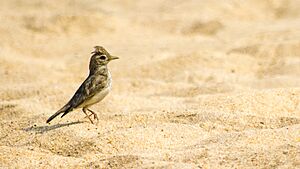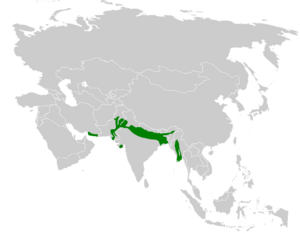Sand lark facts for kids
Quick facts for kids Sand lark |
|
|---|---|
 |
|
| Sand Lark adult at its habitat | |
| Conservation status | |
| Scientific classification | |
| Genus: |
Alaudala
|
| Species: |
raytal
|
 |
|
| Synonyms | |
|
|
The sand lark (Alaudala raytal) is a small passerine bird found in the lark family, Alaudidae. Passerine birds are also known as "perching birds." You can find sand larks in southern Asia. They look a bit like short-toed larks, but they are smaller.
Contents
About the Sand Lark's Name
The sand lark has had a few different scientific names over time. It was first put into the Alauda group. Later, it moved to the Calandrella group. In 2014, scientists moved it back to the Alaudala group.
Sometimes, people call this bird the Asian short-toed lark. However, that name usually refers to a different bird, Alaudala cheleensis. Other names for the sand lark include Ganges sand lark, Indian sand lark, and Indian short-toed lark. The name raytal comes from a Hindi word, retal, which means "sandy."
Different Types of Sand Larks
Scientists recognize three main types, or subspecies, of the sand lark:
- Indus sand lark (A. r. adamsi) - This type lives in southeastern Iran, Pakistan, eastern Afghanistan, and northwestern India.
- A. r. raytal - This type is found from north-central India all the way to southern Myanmar.
- A. r. krishnakumarsinhji - You can find this type in west-central India.
What Does a Sand Lark Look Like?
The sand lark is a small bird, about 12 to 13 centimeters (around 5 inches) long. Its look can change a bit depending on where it lives. All sand larks are dull brownish-grey. They have faint streaks on their upper body.
They also have a noticeably short tail and a thin beak. The beak's length changes depending on the region. Birds in the western part of their range have shorter, stubbier beaks. Those in the eastern part have longer, finer beaks.
The krishnakumarsinhji subspecies, found in Gujarat, India, is greyer. It has clear dark streaks on its upper feathers and chest. Its face, under its eyes, and its entire underside are white. Other subspecies have fine streaks on their whitish chests.
Where Do Sand Larks Live?
You can find sand larks along the sandy banks of several major rivers. These include the Indus, Brahmaputra, Irrawaddy, and Chindwin Rivers. They also live along the Narmada River, but they are less common there.
These birds mostly live on sandy islands in rivers. They also like nearby fields, coastal sand dunes, and dry mud-flats.
Sand Lark Behavior and Life
Sand larks are usually seen alone, in pairs, or in small, loose groups. They look for food by moving quickly in zigzag patterns on sandy banks near water. They eat insects and seeds.
Reproduction and Nesting
The sand lark's breeding season is from February to May. The male's song is quite varied. It includes rattling and tinkling sounds high in the air. Then, as it flies lower, it makes dry rattling and whistling notes.
Their flight involves soaring high, then flapping their wings fast. They pause before floating down in steps, like a parachute. Their wings and tail are spread out during this. For the final part of their descent, they dive straight down. They then land on a small clump of dirt. They might also sing while sitting on the ground, sometimes with their crest feathers slightly raised. They even include calls from other birds in their songs! Their usual call is a clear, tinkling "chissip."
The sand lark builds a deep, cup-shaped nest. It places the nest on the ground, hidden in a patch of plants on the sand. A female usually lays three eggs. The eggs are greyish-white with brown speckles.
Gallery
-
In Koshi Tappu Wildlife Reserve, Nepal






